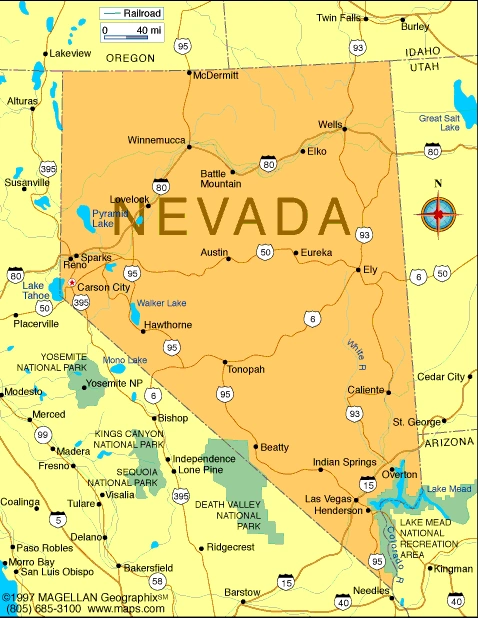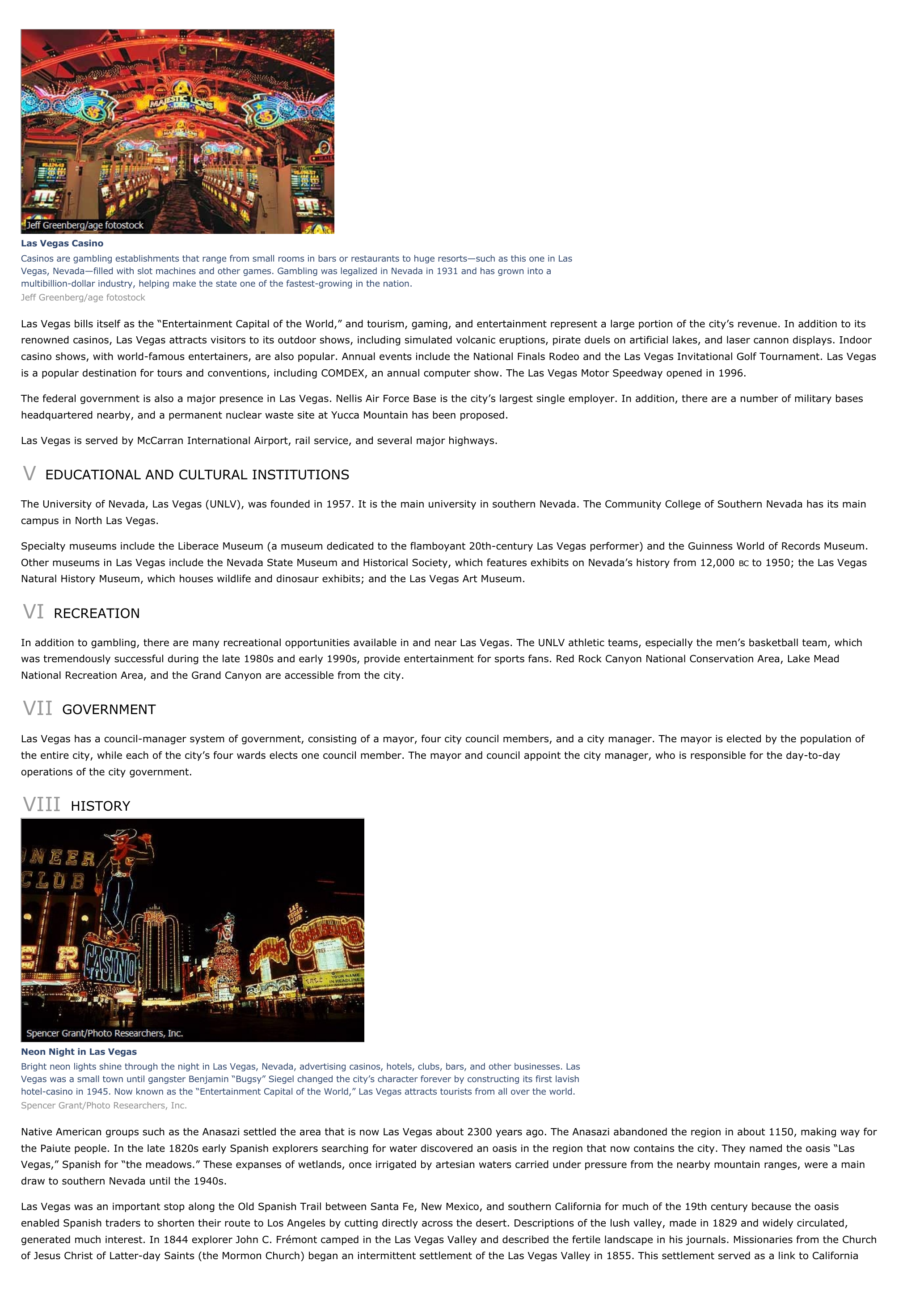Las Vegas (Nevada) - geography.
Publié le 27/05/2013

Extrait du document


«
Las Vegas CasinoCasinos are gambling establishments that range from small rooms in bars or restaurants to huge resorts—such as this one in LasVegas, Nevada—filled with slot machines and other games.
Gambling was legalized in Nevada in 1931 and has grown into amultibillion-dollar industry, helping make the state one of the fastest-growing in the nation.Jeff Greenberg/age fotostock
Las Vegas bills itself as the “Entertainment Capital of the World,” and tourism, gaming, and entertainment represent a large portion of the city’s revenue.
In addition to itsrenowned casinos, Las Vegas attracts visitors to its outdoor shows, including simulated volcanic eruptions, pirate duels on artificial lakes, and laser cannon displays.
Indoorcasino shows, with world-famous entertainers, are also popular.
Annual events include the National Finals Rodeo and the Las Vegas Invitational Golf Tournament.
Las Vegasis a popular destination for tours and conventions, including COMDEX, an annual computer show.
The Las Vegas Motor Speedway opened in 1996.
The federal government is also a major presence in Las Vegas.
Nellis Air Force Base is the city’s largest single employer.
In addition, there are a number of military basesheadquartered nearby, and a permanent nuclear waste site at Yucca Mountain has been proposed.
Las Vegas is served by McCarran International Airport, rail service, and several major highways.
V EDUCATIONAL AND CULTURAL INSTITUTIONS
The University of Nevada, Las Vegas (UNLV), was founded in 1957.
It is the main university in southern Nevada.
The Community College of Southern Nevada has its maincampus in North Las Vegas.
Specialty museums include the Liberace Museum (a museum dedicated to the flamboyant 20th-century Las Vegas performer) and the Guinness World of Records Museum.Other museums in Las Vegas include the Nevada State Museum and Historical Society, which features exhibits on Nevada’s history from 12,000 BC to 1950; the Las Vegas Natural History Museum, which houses wildlife and dinosaur exhibits; and the Las Vegas Art Museum.
VI RECREATION
In addition to gambling, there are many recreational opportunities available in and near Las Vegas.
The UNLV athletic teams, especially the men’s basketball team, whichwas tremendously successful during the late 1980s and early 1990s, provide entertainment for sports fans.
Red Rock Canyon National Conservation Area, Lake MeadNational Recreation Area, and the Grand Canyon are accessible from the city.
VII GOVERNMENT
Las Vegas has a council-manager system of government, consisting of a mayor, four city council members, and a city manager.
The mayor is elected by the population ofthe entire city, while each of the city’s four wards elects one council member.
The mayor and council appoint the city manager, who is responsible for the day-to-dayoperations of the city government.
VIII HISTORY
Neon Night in Las VegasBright neon lights shine through the night in Las Vegas, Nevada, advertising casinos, hotels, clubs, bars, and other businesses.
LasVegas was a small town until gangster Benjamin “Bugsy” Siegel changed the city’s character forever by constructing its first lavishhotel-casino in 1945.
Now known as the “Entertainment Capital of the World,” Las Vegas attracts tourists from all over the world.Spencer Grant/Photo Researchers, Inc.
Native American groups such as the Anasazi settled the area that is now Las Vegas about 2300 years ago.
The Anasazi abandoned the region in about 1150, making way forthe Paiute people.
In the late 1820s early Spanish explorers searching for water discovered an oasis in the region that now contains the city.
They named the oasis “LasVegas,” Spanish for “the meadows.” These expanses of wetlands, once irrigated by artesian waters carried under pressure from the nearby mountain ranges, were a maindraw to southern Nevada until the 1940s.
Las Vegas was an important stop along the Old Spanish Trail between Santa Fe, New Mexico, and southern California for much of the 19th century because the oasisenabled Spanish traders to shorten their route to Los Angeles by cutting directly across the desert.
Descriptions of the lush valley, made in 1829 and widely circulated,generated much interest.
In 1844 explorer John C.
Frémont camped in the Las Vegas Valley and described the fertile landscape in his journals.
Missionaries from the Churchof Jesus Christ of Latter-day Saints (the Mormon Church) began an intermittent settlement of the Las Vegas Valley in 1855.
This settlement served as a link to California.
»
↓↓↓ APERÇU DU DOCUMENT ↓↓↓
Liens utiles
- Las Vegas (Nevada) - geography.
- Nevada - geography.
- Sierra Nevada - geography.
- Sierra Nevada - geography.
- Purviance Edna, 1894-1958, née à Reno (Nevada), actrice américaine.

































